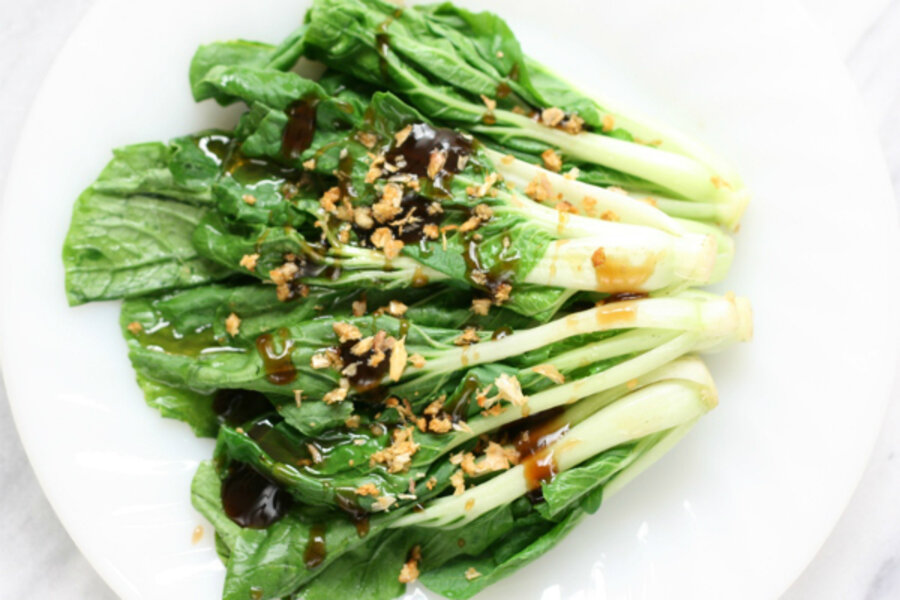Choy sum with oyster sauce and fried garlic
Loading...
Even though I come from good stock — my dad has the greenest of thumbs – I’m not much of a gardener myself. My attempts at growing tomatoes and mesclun last year were not well rewarded. I blame it on the intense sun beating down on our back patio practically all day long.
However, my husband has been encouraging me to try gardening again this year, (I know he’s secretly longing for delicious homegrown tomatoes) and I’ve decided to give it a go. My mission: to try growing Asian vegetables, mostly so I wouldn’t have to make a special trip to the Asian market to buy my favorite vegetables.
As my dream list of vegetables began to grow (hah!)–gailan, bok choy, yu choy, choy sum–it occured to me that with my poor track record, I might need some help.
Choy sum (not to be confused with yu choy sum) is a vegetable I ate frequently as a child. I don’t find it often here in the United States so I thought it would be a good candidate for my gardening endeavors.
Growing Asian vegetables isn’t much different from growing any other vegetable. However, I decided to call on the expertise of Wendy Kiang-Spray who has experience growing all kinds, both common and more obscure. Based in Rockville, Md., Wendy writes and speaks about gardening and food, and volunteers as a D.C. Master Gardener. She’s also working on her first book about growing and cooking Chinese vegetables which will be published by Timber Press in 2016. Wendy’s also blessed with great gardening genes and unlike me, actually knows how to channel them – check out her dad’s gorgeous garden on her blog, greenishthumb.net.
What are some of your favorite Asian vegetables to grow and eat?
Almost all my family members love Chinese broccoli (gailan). It is similar to broccoli raab in that the leaves, stems, flowers are all eaten. I like the texture of this vegetable and go for the middle section where a good hunk of stem meets the leaves. I have family members who only eat the leafy tops, and others who just eat the stems. Gailan offers something for everyone! I also love flowering garlic chives. They are eaten as a vegetable. I love the architecture of the stems. There’s a dish made with flowering garlic chive stems cut into pieces and stir fried with julienned roast duck that is quite amazing. I like how the flowering chive stems offer a mild garlicky flavor that is not overpowering.
Are there any particular vegetables that seem difficult to grow but aren’t really?
Luffa gourds are a fun and easy vegetable to grow. There are 2 types of luffa gourds. We eat both sponge luffa (at a young stage only) as well as angled luffa (also best when young). The sponge type has a wider circumference than the angled luffa and when allowed to mature on the vine, will turn into large scrubby bath sponges! Luffa gourds are easy to grow but need something to climb. Mid-season, yellow flowers will appear on vigorous vines. Luffa gourds grow very quickly and when harvested young, are tender and mild and can be eaten like zucchini or other summer squash. They’re versatile in the kitchen, easy to grow, and the sponges that remain when the fruits are left to mature on the vine make great gifts that will impress your friends (click here for Wendy’s guide to making luffa sponges).
In looking through seed catalogues, Asian vegetables are not very common and even if they are available, they’re usually more mainstream ones like bok choy or cilantro. Where do you get your seeds from?
There are several online seed sources and even mainstream stores and websites are beginning to provide more variety. Kitazawa Seeds, Evergreen Seeds, and Baker Creek all provide a nice variety of Asian vegetable seeds. Asian and international supermarkets are also great places to find seeds.
Do you have any gardening tips from your dad or your own, that you can share?
I think the best way to learn how to grow vegetables is by gaining personal experience. When I do presentations and speaking events, I find I sometimes end up talking more about what NOT to do as I’ve learned from my failures rather than my successes! I think this is because when I take careful notes and keep a presence in the garden all season, each failure is a learning opportunity. Each year my garden (and my dad’s!) gets better and better. Of course, there are always forces of nature that keep us humble. My father’s vegetable garden looks as if it comes from the pages of a magazine and his property looks like a botanical garden. His successes are due to his tenacity and willingness to – as every good gardener does – try again next year.
Any other tips on growing Asian vegetables?
If you are new to Asian vegetables or Asian cooking, the vegetables you try only need to be an exotic as you make them out to be, so no one should be intimidated. As I mentioned, luffa gourds are a great substitution for summer squash. Japanese eggplants are an elegant substitution for globe eggplants, and many people find them less bitter and with fewer seeds. Chinese cucumbers are delicious stand-ins for the plumper cucumbers we know. In fact, many people who have been growing a slimmer, “burpless” cucumber, may have been growing Chinese cucumbers without even knowing it. One of the purposes of my book, is to demystify Chinese vegetables for gardeners who wish to add variety to their garden but need a little support along the way. Readers will find a range of vegetables to try from the bitter melon, something of an acquired taste, to a wide range of Chinese leafy greens that are delicious and easy to use.
Choy Sum with Oyster Sauce and Fried Garlic
Serves 4
This is Wendy’s go-to recipe for any Asian leafy green you might want to grow such as tatsoi, gailan, or bok choy. I, of course, did not grow my choy sum but found them at the Asian market and decided to cook those up. Choy sum ("cai xin" in Mandarin) literally means “vegetable heart,” and their petite size and shape remind me of mini bok choy. Like bok choy, choy sum has green leaves as well as white stems, only slimmer. They taste similar, too. If you can find some, do snap them up! I chose to blanch the choy sum, but feel free to use your favorite method of cooking your greens – boiling, steaming or in the microwave.
1 pound choy sum, washed thoroughly
1/4 cup oyster sauce, or to taste (soy sauce works fine if you are vegetarian)
4 to 5 cloves garlic, chopped
3 tablespoons vegetable oil, like canola
1. Bring a large pot of water to boil over high heat. When it comes to a rolling boil, immerse the choy sum in the water and cook until the leaves turn bright green and the stems are tender, 30 seconds to 1 minute.
2. Scoop out the choy sum with a spider or slotted spoon and place on a serving plate. Top with the oyster sauce.
3. In a small frying pan, heat the oil over medium-high heat. Add the garlic and fry until golden and fragrant, 1 to 2 minutes. Pour the oil and garlic on top of the choy sum and serve with steamed rice and a meat dish.
Notes: You can make the fried garlic in oil ahead of time and double or triple the recipe and use it to garnish salads and soups. It keeps on the counter for one week. Or you can just buy fried garlic in tubs at the Asian store.
Related post on Pickles and Tea: Collard greens with tofu and coconut sauce






